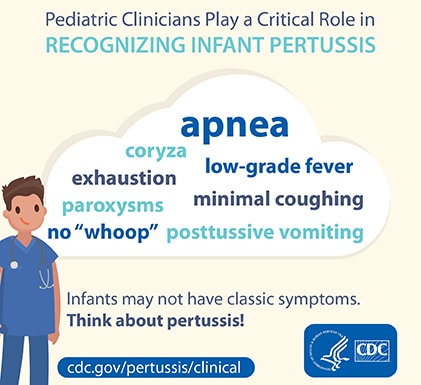Clinical Features
Educate parents to consider pertussis when their child has a cough or apnea. Let them know that it can be a severe illness, especially for infants, and they should seek immediate treatment.
Inquire about contact with infants and pregnant women when you suspect a case in an older child, adolescent, or adult. Learn about use of postexposure antimicrobial prophylaxis.
Stages to the Clinical Course of Pertussis
Characterized by:
- Coryza
- Low-grade fever
- Mild, occasional cough (which gradually becomes more severe)
- Apnea (in infants)
Characterized by:
- Paroxysms of numerous, rapid coughs due to difficulty expelling thick mucus from the tracheobronchial tree
- Long inspiratory effort accompanied by a high-pitched “whoop” at the end of the paroxysms
- Cyanosis
- Vomiting Exhaustion
Paroxysmal attacks:
- Occur frequently at night, with an average of 15 attacks per 24 hours
- Increase in frequency during the first 1-2 weeks, remain at the same frequency for 2-3 weeks, and then gradually decrease
Characterized by:
- Gradual recovery
- Less persistent, paroxysmal coughs that disappear in 2-3 weeks
Paroxysms often recur with subsequent respiratory infections for many months after the onset of pertussis.

Infants may not have classic symptoms and only present with apnea.
Incubation period and disease progression
Pertussis symptoms usually develop within 5 to 10 days after exposure, but sometimes not for as long as 21 days. Pertussis has an insidious onset with catarrhal symptoms that are indistinguishable from those of minor respiratory tract infections. The cough, which is initially intermittent, can become paroxysmal. In typical cases, paroxysms terminate with “inspiratory whoop” and posttussive vomiting can follow.
Paroxysms of cough, which may occur more at night, usually increase in frequency and severity as the illness progresses. The cough typically persists for 1 to 6 weeks or more. After paroxysms subside, a nonparoxysmal cough can continue for 2 to 6 weeks or longer.
Disease may present differently in certain people
Unvaccinated or incompletely vaccinated infants younger than 12 months of age have the highest risk for severe complications and death. In infants, apnea may be the only symptom and the cough may be minimal or absent. There is increasing awareness and recognition of pertussis as a disease that affects adolescents and adults. However, clinicians often overlook pertussis in the differential diagnosis of cough illness in this population. Illness is generally less severe, and the typical “whoop” less frequently seen in adolescents and adults.
The illness can be milder and the characteristic paroxysmal cough and “whoop” may be absent in children, adolescents, and adults who were previously vaccinated.
- Pink Book’s Chapter on Pertussis
Epidemiology and Prevention of Vaccine-Preventable Diseases textbook - Red Book
- CME: Does This Coughing Adolescent or Adult Patient Have Pertussis?
2010 JAMA article with CME
